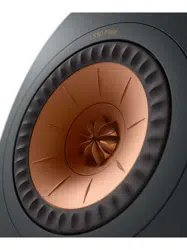Loading ...
Loading ...
Loading ...

22 23
Even measuring off axis in the horizontal plane results
in unequal path differences once the angle is large
enough that the radiation from the bass driver does
not travel directly to the microphone, but has to travel
rst to the front of the cone.
The result is that any phase correction in the crossover
is only valid directly on axis. In fact, any blending at all
of the two drivers suffers phase distortion off axis.
Not so with a Uni-Q combination; the two drivers
remain at the same point in space and have the same
distance to the microphone, whatever the angle of
measurement.
Having established just how suitable a Uni-Q speaker
is for phase correction, let’s see how effective the
process is. Here is an input signal - a square wave of
1kHz:
Figure 52
Conventional speaker, mic. above axis.
Figure 53
Conventional speaker, mic. below axis.
Figure 54
Conventional speaker, mic. horizontally off axis.
Figure 55
Uni-Q speaker on & off axis
Figure 56
Input signal - 1kHz square wave
This is how the output of the speaker would look with
the phase correction switched OFF:
And this is how it looks with the phase correction
switched ON:
Bass Extension
There are three settings, which should be chosen
in conjunction with the room acoustics The “Less”
setting is similar to the natural bass extension of the
passive version, giving a cut-off frequency of 46Hz
(-6dB). The “Standard” and “Extra” settings give cutoff
frequencies of 43Hz and 40Hz respectively.
Normally, the “Extra” setting will be chosen, unless
there is a particularly bad room resonance around
30- 40Hz, where one of the higher cut-off settings will
compensate.
In addition, there is a dynamic bass stage that limits
the driver excursion whatever the setting. This
prevents excessive distortion and protects the driver
from possible damage. The application is practically
unnoticeable - however the effect is creating a
loudspeaker that sounds larger than it actually is.
Should the user prefer to be unbounded by the
limitations of a small bass driver, there is always the
option of adding one or two subwoofers.
Adding a Subwoofer
Either one or two subwoofers may be added to
reinforce the bass of the audio system.
Each speaker (Primary or Secondary) has a Subwoofer
Out socket (RCA Phono). The signal sent to both
subwoofer outputs is a summed mono signal.
A crossover between the LS50 Wireless II and the
subwoofer is provided and the crossover frequency is
set within the app. There is no choice of lter shape - it
is always a 4th-order Linkwitz-Riley giving -6dB at the
cut-off frequency and a at in-phase total response.
If there is any low-pass lter supplied with the
subwoofer, it should be bypassed if possible or, if not,
the frequency should be set to the highest possible.
The choice of crossover frequency is something of a
compromise. The higher it is, the less the excursion
demands on the LS50 and the louder the whole
system can play. However, if a mono subwoofer output
is selected and the crossover frequency is too high,
some of the stereo information is lost. 80Hz is usually
considered the highest to avoid any perception of loss
of stereo information and the lower it is the better in
this respect.
In Basic setup mode, the cut-off frequencies of the
high-pass to the LS50 Wireless II and the low-pass
to the subwoofer(s) are always the same and this
is normally the course to follow. However, some
subwoofers do not have a at response and different
cut-off frequencies may give better results. Having
different frequencies requires the user to use Expert
mode for setup.
Figure 57
Speaker output - Phase Correction OFF
Figure 58
Speaker output - Phase Correction ON
Loading ...
Loading ...
